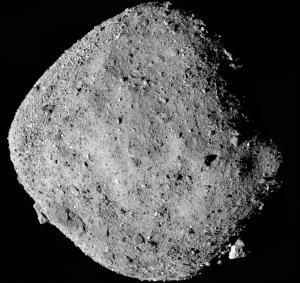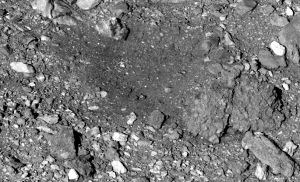Asteroid wears boulder body armor for protection
University of Hawaiʻi at MānoaAssistant Researcher, HIGP, School of Ocean and Earth Science and Technology
Marcie Grabowski, (808) 956-3151
Outreach specialist, School of Ocean and Earth Science and Technology
Asteroid Bennu’s boulder-covered surface gives it protection against small meteoroid impacts, according to observations of craters by NASA’s OSIRIS-REx spacecraft. The findings were reported in a study published in Nature Geoscience and co-authored by University of Hawaiʻi at Mānoa planetary geologist, David Trang.
Bennu is a “rubble-pile” asteroid, meaning that it formed from the debris of a much larger asteroid that was destroyed by an ancient impact. Fragments from the collision coalesced under their own weak gravity to form Bennu.
Assessing craters
The team used unprecedented, high-resolution global data sets to examine craters on Bennu: images from the OSIRIS-REx Camera Suite, and surface-height data (topography) derived from the OSIRIS-REx Laser Altimeter, a laser-ranging (lidar) instrument on the spacecraft.
“Measuring craters and their population on Bennu was exceptionally exciting,” said Trang, an assistant researcher at the Hawaiʻi Institute of Geophysics and Planetology in the UH Mānoa School of Ocean and Earth Science and Technology. “At Bennu, we discovered something unique to small and rocky bodies, which expanded our knowledge of impacts.”
“These observations give new insight into how asteroids like Bennu respond to energetic impacts,” said Edward (Beau) Bierhaus of Lockheed Martin Space, Littleton, Colorado, lead author of the study.
Scientists estimate the age of planetary surfaces by measuring the abundance and sizes of craters, if the craters are not being erased by erosion from wind and water or buried by lava flows or other processes. Impact craters accumulate over time, so a surface with many craters is older than a surface with few craters. Also, the size of the crater depends on the size of the impactor, with larger impactors generally making larger craters. Since small meteoroids are far more abundant than large meteoroids, celestial objects like asteroids usually have many more small craters than large ones.
Unusual findings
Bennu’s large craters follow this pattern, with the numbers of craters decreasing as their size increases, but only to a point. However, for craters smaller than about 6.6 feet, the trend is backwards, with the number of craters decreasing as their size decreases. This indicates something unusual is happening on Bennu’s surface.
The researchers think that Bennu’s profusion of boulders acts as a shield, preventing many small meteoroids from forming craters. Instead, these impacts are more likely to break apart the boulders or chip and fracture them. Also, some impactors that do make it through the boulders make smaller craters than they would if Bennu’s surface was covered in smaller, more uniform particles, like beach sand.
The team also found that the number of small and large craters offered different estimates for Bennu’s surface age, revealing the asteroid’s long and winding road through space.
The result supports the idea that Bennu was formed in the main asteroid belt between Mars and Jupiter, but the pull of gravity from other objects in the solar system sent it to the region of space near Earth.
“The crater sizes found throughout Bennu has helped us understand the story and life of this small asteroid, Bennu; it’s like scars found on a body, which also tells its own story,” said Trang. “Importantly these craters told us that Bennu didn’t always live near Earth space as it does today, but once lived in the main asteroid belt. Then somehow many of these craters were erased, but then accumulated a new set of craters, which are smaller than those found on the Moon due to boulder armor.”
For more information and a full list of collaborators, visit NASA News.


